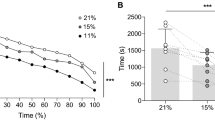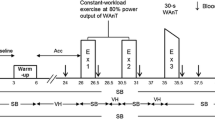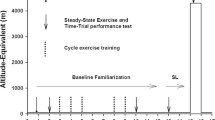Summary
Two investigations were designed that (a) evaluated the effect of the respiratory alkalosis that accompanies breathing an hypoxic (H) gas mixture and (b) examined the influence of the duration of breathing this H mixture on the subsequent performance of 45 s supramaximal dynamic exercise. In experiment 1, 12 men performed a 45-s Wingate Test (WT) on three occasions breathing a normoxic (N; 20.9% 02), H (11.3% 02), or normocapnic hypoxic (H + CO2; 11.5070 O2, 2.25% CO2) gas mixture for 20 min prior to performing the WT. For experiment 2, nine men performed a 20-min normoxic (N20) and three hypoxic WT trials which consisted of breathing an 11070 O2 balance N2 gas mixture for 10 min (H10), 20 min (H20) or 30 min (H30) prior to the WT. For experiment 1,VO2 was significantly reduced during the 45-s H [mean (SD); 1.22 (0.23) 1] and H + CO2 [1.12 (0.18)1] trials compared with the N trial [1.78 (0.18) 1]. Peak power output (W peak) during WT was similar across trials. However, a small (less than 3070) but significant reduction in the mean power output (W) was observed in both the H and H + CO2 trials [6.8 (0.6) W · kg−1] compared with the N trial [7.0 (0.6) W · kg−1]. Prior to performing the WT, blood pH andPCO2 were similar [7.40 (0.02) and 5.3 (0.3) kPa, respectively] for the N and H + CO2 trials. A respiratory alkalosis accompanied the H condition [7.46 (0.02) for pH and 4.6 (0.3) kPa forPCO2. For experiment 2,VO2 also was significantly lower during the 45-s WT for H10 [1.16 (0.16) 1], H2O [1.17 (0.16)1], and H30 [1.18 (0.26) 1] compared with N20 [1.84 (0.41) 1].W peak was similar across trials but a significant reduction in meanW was observed again for the H trials [7.1 (0.4) W · kg−1] compared with N20 [7.4 (0.4) W · kg−1]. These data conflict with our previous findings and suggest that breathing an 11% H gas mixture will reduce the mean power produced during 45 s of supramaximal exercise.
Similar content being viewed by others
References
Bubb WJ, Howley ET, Cox RH (1983) Effects of various levels of hypoxia on plasma catecholamines at rest and during exercise. Aviat Space Environ Med 54:637–640
Coggan AR, Costill DL (1984) Biological and technological variability of three anaerobic ergometer tests. Int J Sports Med 5; 142–145
Collomp K, Ahmaidi S, Audran M, Chanal J-L, Prefaut C (1991) Effects of caffeine ingestion on performance and anaerobic metabolism during the Wingate test. Int J Sports Med 12:439–443
Connett RJ, Honig CR, Gayeski TEJ, Brooks GA (1990) Defining hypoxia: a systems view of Y02, glycolysis, energetics, and intracellularPO2. J Appl Physiol 68:833–842
Dotan R, Bar-Or O (1980) Climatic heat stress and performance in the Wingate anaerobic test. Eur J Appl Physiol 44:237–243
Eldridge FL, T'So L, Chang H (1974) Relationship between turnover rate and blood concentration of lactate in normal dogs. J Appl Physiol 37:316–320
Escourrou P, Johnson DG, Rowell LB (1984) Hypoxemia increases plasma catecholamine concentrations in exercising humans. J Appl Physiol 57:1507–1511
Forster HV, Dempsey JA, Thompson J, Vidruk E, DoPico GA (1972) Estimation of arterialPO2,PCO2, pH and lactate from arterialized venous blood. J Appl Physiol 32:134–137
Inman MD, Hughson RL, Weisiger RK, Swanson GD (1987) Estimate of mean tissue 02 consumption at onset of exercise in males. J Appl Physiol 63:1578–1585
Lindinger MI, Heigenhauser GJF, Spriet LL (1990) Effects of alkalosis on muscle ions at rest and with intense exercise. Can J Physiol Pharmacol 68:820–829
MacDonald IA, Wootton SA, Muñoz B, Fentem PH, Williams C (1983) Catecholamine response to maximal anaerobic exercise. In: Knuttgen HG, Vogel JA, Poortmans J (eds) Biochemistry of exercise, vol 13. Human Kinetics, Champaign, Ill., pp 749–754
McLellan TM, Kavanagh MF, Jacobs I (1990) The effect of hypoxia on performance during 30 s or 45 s of supramaximal exercise. Eur J Appl Physiol 60:155–161
Morrow JA, Fell RD, Gladden LB (1988) Respiratory alkalosis: no effect on blood lactate decline or exercise performance. Eur J Appl Physiol 58:175–181
Patton JF, Murphy MM, Frederick FA (1985) Maximal power outputs during the Wingate anaerobic test. In J Sports Med 6:82–85
Richter EA, Ruderman NB, Gavras H, Belur ER, Galbo H (1982) Muscle glycogenolysis during exercise: dual control by epinephrine and contractions. Am J Physiol 242:E25-E32
Rowell LB, Johnson DG, Chase PB, Comess KA, Seals DR (1989) Hypoxemia raises muscle sympathetic activity but not norepinephrine in resting humans. J Appl Physiol 66:1736–1743
Seals DR, Johnson DG, Fregosi RF (1991) Hypoxia potentiates exercise-induced sympathetic neural activation in humans. J Appl Physiol 71:1032–1040
Sutton JR, Jones NL, Toews CJ (1981) Effect of pH on muscle glycolysis during exercise. Clin Sci 61:331–338
Author information
Authors and Affiliations
Rights and permissions
About this article
Cite this article
McLellan, T.M., Cheung, S.S. & Meunier, M.R. The effect of normocapnic hypoxia and the duration of exposure to hypoxia on supramaximal exercise performance. Europ. J. Appl. Physiol. 66, 409–414 (1993). https://doi.org/10.1007/BF00599613
Accepted:
Issue Date:
DOI: https://doi.org/10.1007/BF00599613




